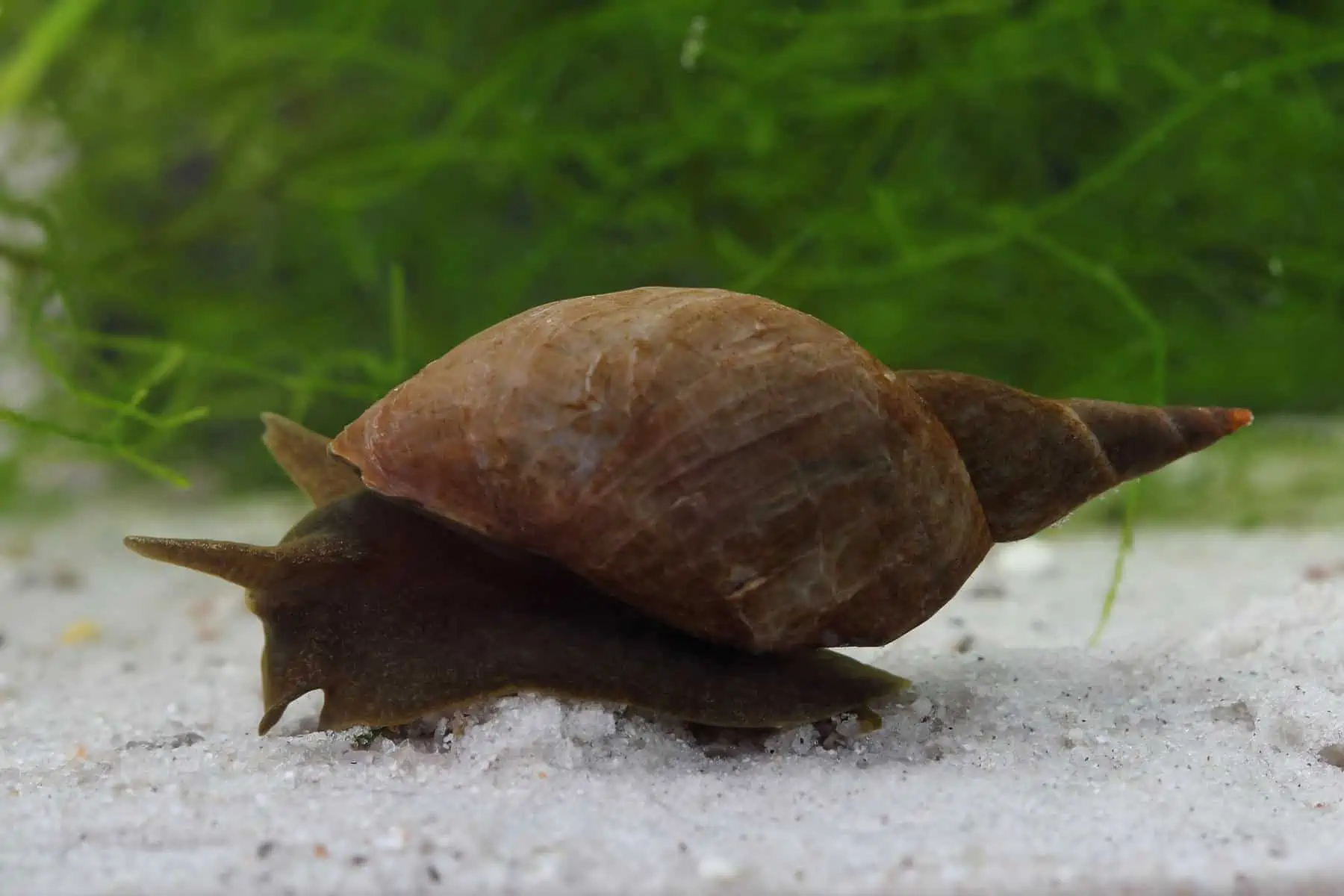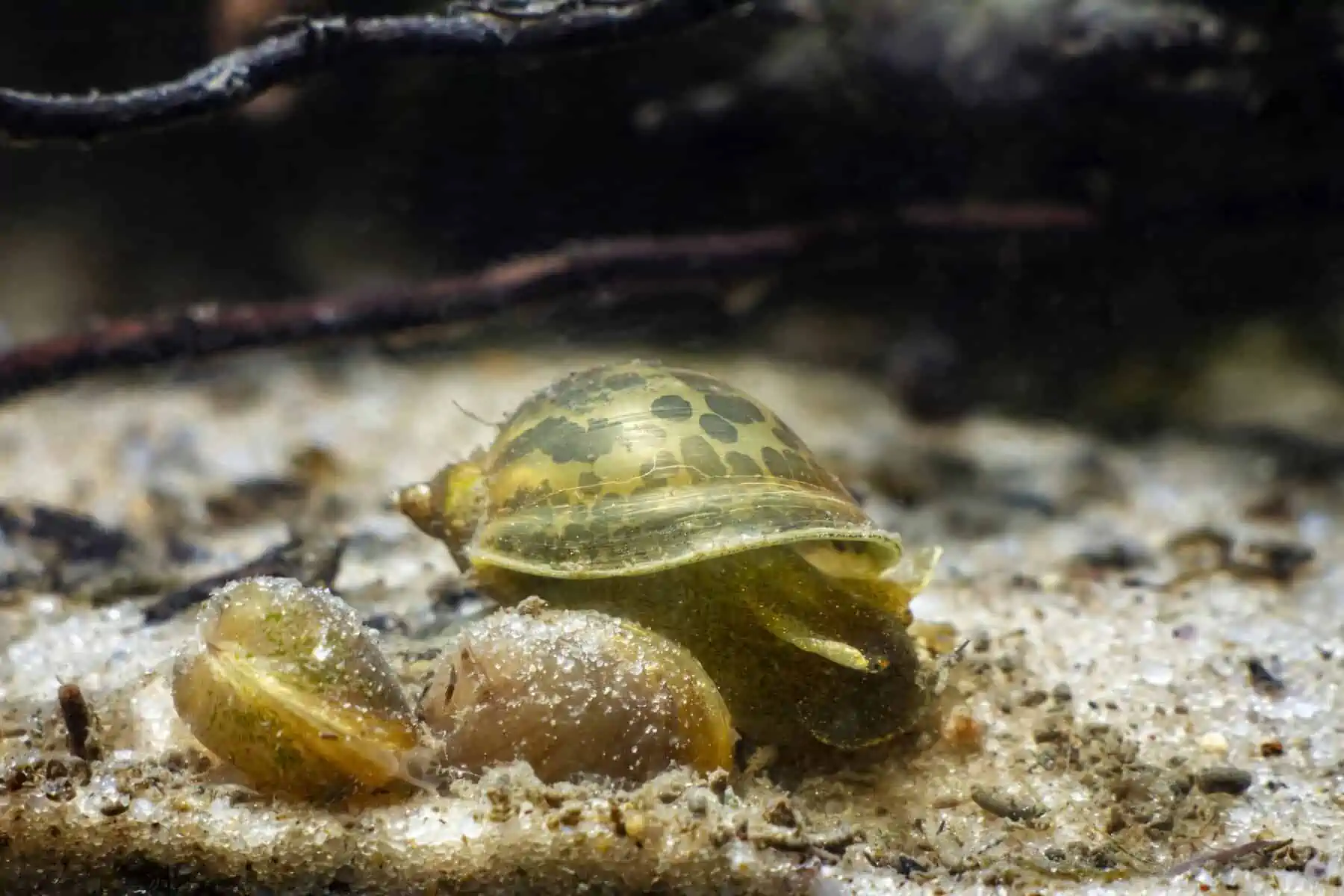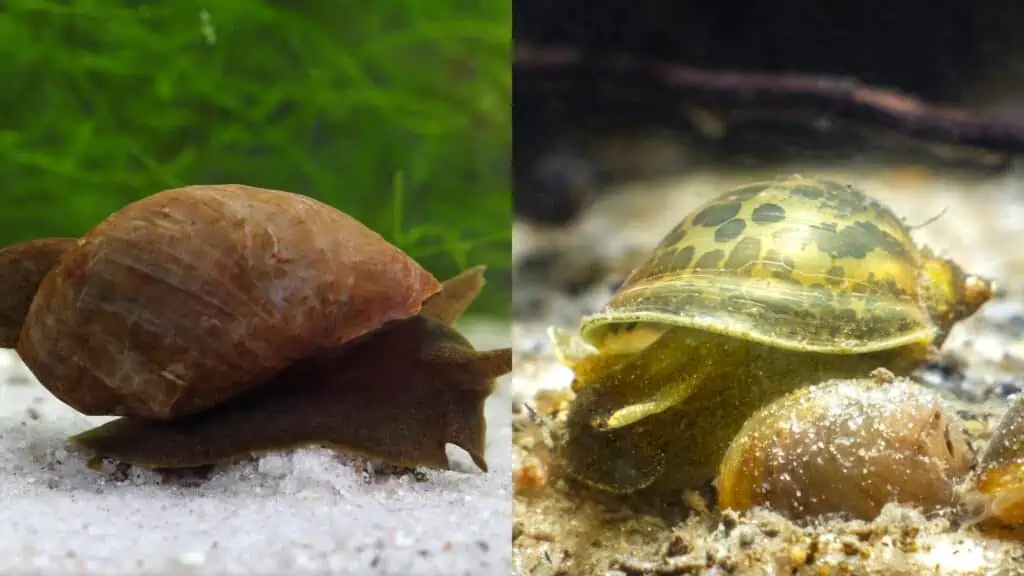Are you thinking about hiring a clean-up crew for your tank, but are unsure which type of snail you have? Well, you’re not alone! At a glance, pond snails and bladder snails may look very similar.
However, there are a few key differences between the pond and bladder snails, including their physical appearance, habitat preferences, and lifespans. For starters, pond snails have a more dome-shaped shell with noticeable ridges on the exterior.
In contrast, bladder snails have more elongated shells that taper towards the opening at one end, making them look somewhat like a tube.
In this article, I’ll take a closer look at pond snails and bladder snails, including their preferred habitats, molting behaviors, and feeding habits.
Pond Snail vs Bladder Snail – Summary
| Pond Snail | Bladder Snail | |
|---|---|---|
| Distinct appearance | Dextral shell (turned to the right) | Sinistral shell (turned to the left) |
| Size | Up to 2-3 inches | Often smaller than <1” |
| Diet | Omnivore / Algae eater | Omnivore / Algae eater |
| Habitat | Stagnant waters | Stagnant/Slow-moving waters |
| Care Level | Very easy | Very easy |
| pH Level | 6.5 – 8 | 6 – 9 |
| Water Temperature | 32°F – 90°F | 32°F – 90°F |
What Do Pond Snails & Bladder Snails Have in Common?
Hermaphrodites and Prolific Breeders
Unlike most animals, both pond snails and bladder snails can choose their sex depending on the environment around them. However, if they can’t find a mate, these creatures are capable of self-fertilization.
These freshwater snails are hermaphrodites, which means they have both male and female reproductive organs. A sperm storage organ allows them to self-fertilize by taking on the roles of both male and female snails.
Without a doubt, both pond and bladder snails will mate with another snail if possible, but if not, they are still capable of self-fertilization. Typically, this happens when the snail feels like it’s in danger or after 6 to 8 weeks have passed without finding a partner.
Through either method of reproduction, too many snails can quickly become an issue in your freshwater tank if you overfeed your fish – more food equals more snails!
Extremely Adaptable
Aquatic snails are naturally robust creatures that can tolerate extreme conditions in their wild habitats. Their resilience is one of the reasons why pond and bladder snails do so well in an aquarium, where water quality is more stable.
Even if there are sudden changes in the pH level, hardness, or temperature of the water, aquarium snails won’t be significantly affected.
Or, in other words, if you have a temperate between 59 to 86°F then both pond and bladder snails will do well and may even reproduce!
Calcium Needs
Pond snails and bladder snails require calcium for their shells to grow and harden enough so that they can become protected from predators.
If there is a severe lack of calcium sources in an aquarium, it might stop aquatic snails from growing or reproducing, both of which lower their chances of survival.
If you want your little mollusk tank cleaners to have a symbiotic relationship with you, add antacids (Tums), cuttlefish bones, or even crushed-up eggshells to your aquarium.
By taking these calcium supplements, you can be sure that your snails will remain healthy and happy without negatively impacting the fish they share a home with.
They Reproduce Too Much
If you overfeed your fish regularly, expect an increase in the snail population, as they will take advantage of the excess food. Pond and bladder snails are known for being gluttons and will eat continuously if given the chance.
If you’re battling a never-ending infestation of slugs, consider one of these two methods to help get the population under control:
- Add a snail-eating fish to your tank to help control the snail population
- To set up a lettuce trap, leave a leaf at the bottom of your tank for some hours and then remove it – you should see quite a few snails attached to the leaf
What Are the Differences between Pond Snails and Bladder Snails?
Compatibility With Plants
Pond Snails
Pond snails should not be trustworthy in planted tanks because they feast on aquatic plants and pond plants. Just as they would gorge on vegetation in the wild!

Bladder Snails
At first glance, bladder snails in planted tanks might not seem like they would be welcome guests. However, these snails are actually really helpful! They only eat rotting or diseased plants, so they won’t damage any healthy plants.
In fact, they will help keep the aquarium clean by acting as an always-on-duty gardener. Also, bladder snails can be used in quarantine plant tanks, since they consume any decaying plant matter.
Thus, you can transfer plants without worry to their final destination.
Pests or Cleaners?
Pond Snails
Pond snails are generally considered to be pests. The only useful role they can take on in a fish tank is as live food for some freshwater predators. Here are some freshwater fish that like to eat snails:
- Clown Loach
- Betta Fish
- Goldfish
- Yoyo Loach
- Cory Catfish
- Green Spotter
- Puffer
- Gourami Fish
- Bala Shark
- Assassin Snail
Bladder Snails
Most people believe aquarium snails are nothing but pests. But what if a certain species of aqua snail had a positive quirk? Would that change the way we see them?
In fact, bladder snails are excellent cleaners, and if you allow them to live in your tank, they will do their part to keep it clean.
Size
Pond Snails
With the right conditions and care, pond snails can grow up to 1-3 inches. They have the potential to get even bigger in size if they live in the wild, though.
Bladder Snails
Bladder snails are very small, only growing to be a maximum of ½ to 1-inch long.
Lifespan
Pond Snails
Compared to other types of snails, pond snails are more resilient and can live for up to 3 years in suitable conditions.
Bladder Snails
Bladder snails have a much shorter lifespan of only 2 years.
Origin
Pond Snails
The pond snail is an invasive creature, making its native habitat difficult to pinpoint. This snail species has spread to: northern Asia, northern America, Tasmania, New Zealand, Europe, and even the Yukon River/Alaska.
Bladder Snails
You can find bladder snails all over the world, from Europe and Asia to Africa, Australia, and North and South America. They haven’t made it to Antarctica yet, but who knows? These little guys seem to be able to go anywhere they want!

Habitat
Pond Snails
The scientific name for pond snails is “Lymnaea stagnalis,” which alludes to their love of stagnant and motionless environments. If you’re looking to create a habitat where pond snails will thrive, opt for calm waters with lots of vegetation.
With a pond snail’s natural preference for colder waters, it can still survive in other bodies of water such as reservoirs, streams, lakes, ponds, marshes, and more.
Bladder Snails
Bladder snails can survive in a variety of habitats, including slow-moving rivers and streams, lakes, rice fields, ditches, irrigation canals, and municipality drains. They aren’t picky creatures and will live anywhere they can find suitable conditions.
Appearance
Pond Snails
Pond snails have a shell that is dextral, meaning it spirals to the right. Also, the shell tapers in thickness towards a wide opening. Usually, pond snail shells are different shades of yellow-brown with tiny dark spots scattered about.
However, the most distinctive physical feature of these creatures would be their thick triangular-shaped tentacles.
In addition, the Lymnaea stagnalis doesn’t have an operculum or a “lid.” The shape and color of its shell can change based on external factors, such as where it lives or its age.
Bladder Snails
Bladder Snails have an ovate, sinistral shell that turns to the left in 4-5 horizontal whorls. Plus, the shells are nearly transparent and can be varying shades of light yellow to brown. Like pond snails, they lack an operculum. Their tentacles appear threadlike and elongated.
Diet
Pond Snails
The pond snail is a huge fan of algae and is considered to be an omnivore. In their natural habitat, they will consume enormous amounts of aquatic plants (healthy or decomposing).
When kept in a freshwater tank, your snail’s diet should consist of 75% leftover fish food, aquatic plants, and fish waste — with the remaining 25% being algae.
Pond snails will consume both the soft and hard parts of your aquatic plants, making them unsafe for plant life. When food is scarce, they may turn to their smaller counterparts out of desperation.
Bladder Snails
Thanks to their love of anything decaying and organic, bladder snails make for excellent tank cleaners. They’re not picky when it comes to food, so you’ll often find them munching on dead fish, rotting plants, and other insects.
Although they do have a reputation for eating healthy plants too, that’s actually not the case. Bladder snails are 100% plant-safe and will only eat diseased parts of a plant.
Tank Conditions
Pond Snails
Regardless of its native habitat, the pond snail isn’t picky about water parameters or tank sizes.
Large tanks or small fish bowls, filter/no-filter, heater/no-heater, air pumps on or off—it doesn’t make a difference to them! These guys are robust creatures that thrive in most aquatic setups.
Even though they are durable, these snails need fresh water changes on occasion. You will have to do this even if you’re breeding them for other animals to eat.
Also, a lack of calcium sources and/or a pH level lower than 6.5 for an extended period of time is the only combination of tank conditions that can negatively impact pond snails. This mixture of factors interferes with the snail’s ability to form a shell.
Bladder Snails
The bladder snail is a “sewage snail” among aquarists because of its ability to cycle tank water quickly and efficiently. These snails are highly resilient creatures that can thrive in almost any type of water condition.
Reproduction & Breeding
Pond Snails
As they are hermaphrodite creatures, pond snails are able to cross-fertilize with a partner or self-fertilize depending on the situation.
With a lifespan of 1-3 years, these animals reach sexual maturity at around 2 ½ to 3 ½ months old. When mating, younger pond snails tend to take more male roles.
After the male pond snail climbs on top of the female’s shell, he will turn it counter-clockwise until he reaches her gonopore. Then, he will initiate fertilization.
The entire process can last a few hours, but don’t be fooled– these creatures are prolific breeders and a population can explode in no time.
Bladder Snails
Very similar to most hermaphroditic aquatic snails, the bladder snail has a sperm storage organ. This allows them to mate using either male or female reproductive organs, and they can even self-fertilize if needed.
Also, bladder snails will lay encapsulated transparent eggs, which hatch within a week of being laid. Like pond snails, they can breed tons of offspring in a short amount of time.
Compatibility With Other Fish
Pond Snails
While pond snails don’t have many friends in the aquarium world, they are typically at risk when sharing a tank with aggressive fish or freshwater predators. For example, loaches, pufferfish, betta fish, and others will see them as delicious snacks.
Bladder Snails
The bladder snail is a helpful pest that will clean your freshwater tank without bothering other fish.
If given the chance, loaches, Oscars, crayfish, pufferfish, and other larger snails may eat them. However, this can actually be beneficial as it will help control the population of these snails.
Behavior
Pond Snails
By nature, pond snails are peaceful creatures that will typically mind their own business in any tank.
However, when they feel threatened or endangered, they will flick their shells back and forth in a quick, jerky motion. Additionally, pond snails can be cannibals at times and may eat smaller snails if given the opportunity.
Bladder Snails
The bladder snail’s only form of defense against predators is the quick movement of its shell. You would be astonished to see them crawling through the tank at a high speed (although, admittedly, not as fast as some other creatures).
Surviving Without Water
Pond Snails
Pond snails can breathe in two ways: Cutaneous respiration, absorbing oxygen through their skin, and Aerial respiration, getting oxygen from the atmosphere using a rudimentary lung.
When pond snails live in toxic or polluted water, they use a type of breathing called aerial respiration.
To do this, they find their way to the surface of the water and open a breathing pore while contracting and relaxing a lung-like organ. This allows them to survive on land for up to 2 days without water.
Bladder Snails
Bladder snails possess a pulmonary organ that helps them breathe air, which gives them the ability to live outside of water for shorter periods of time.
They don’t necessarily die from a lack of oxygen when removed from their aquatic environment but rather because they become too dry.
FAQs
Are Pond Snails the Same as Bladder Snails?
Pond snails and bladder snails are two distinct types of aquatic snails that have different physical characteristics and behaviors.
While pond snails tend to be larger than bladder snails and have a wider range of colors, bladder snails are smaller and more brightly colored.
Can Bladder Snails Live in Ponds?
Bladder snails can live in ponds, but they are most often found in freshwater tanks and aquariums.
They prefer warm, humid environments that provide plenty of food sources, such as algae and plant matter.
Can I Put Aquarium Snails in a Pond?
You can put pond snails in a pond, but you shouldn’t put bladder snails in an aquarium. Aquarium snails are more sensitive to temperature and water conditions than pond snails, so they may not survive long without the right environment.
How Do You Identify Pond Snails?
Pond snails can be identified by their large, smooth shells that are typically light brown or tan in color. They also have a long proboscis-like mouth and two small tentacles on either side of their head.
Last Words
You see, pond snails and bladder snails are highly resilient creatures that can thrive in almost any type of water condition. Whether it’s a pond, aquarium, or backyard pond, these aquatic pests will always find a way to adapt and survive.
With the right care and maintenance, you can keep your tank free of these pesky snails for good. So what are you waiting for? Get out there and start pond snail-slimming today!
I hope this content has been helpful in your pond snail vs bladder snail battle. If you have any other questions or concerns, feel free to reach out anytime.


